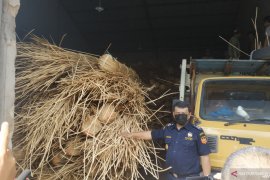According to Deputy General Chair of the Indonesian Rattan Entrepreneurs Association Julius Hoesan, rattan industries currently use only some five to 10 percent of the total potential of sustainable Indonesian rattan resources.
The potential of sustainable Indonesian raw rattan is 630 thousand tons per year. When processed into semi-finished goods, it stood at 250 thousand tons per year. There are still many that are unused by the industry.
Thus, Indonesia still has huge rattan potential that can be exploited commercially, especially to increase its rattan-based product exports.
Indonesia was a major exporter of raw rattan products in the past, but it stopped its raw rattan exports in 2011, encouraging local industries to process the commodity at home to gain added values before they are exported.
Several rattan farmers and collectors at that time complained about the ban on raw rattan exports, arguing that rattan industries are not able to absorb their produce. The value of Indonesia`s processed rattan-based exports had continued to increase since then.
The trade minister issued Decree Number 35 of 2011, banning the export of raw rattan in an effort to increase rattan`s added value. The decree had a positive impact on Indonesia`s rattan-based product exports.
Data from the Indonesian Rattan Handicraft and Furniture Industry Association (Asmindo) revealed that Indonesia`s rattan exports in 2010 were valued at US$137.9 million, a 9.6 percent increase as compared to those in 2009. However, figures dropped by 17.6 percent to $113.6 million in 2011 due to the global economic crisis.
The exports increased again in 2012 and 2013 to $202.6 million and $262.5 million, respectively.
Owing to the ban on raw rattan exports, Indonesia`s exports of rattan-made products jumped, from $137.9 million in 2010 to $1.71 billion in 2015.
However, to boost exports, the government began to allow the exportation of semi-finished products in 2017. Yet, over the past three years, exports seemed to be stagnant. Hence, Industry Minister Airlangga Hartarto called on rattan industries to boost exports.
Airlangga stressed that the government had secured rattan raw material by stopping its exports, so that it can be utilized optimally by domestic businesses.
"Hence, if entrepreneurs could not boost the exports of their rattan products, we will allow the exportation of raw rattan again," Hartarto stated wittily while visiting rattan industries in Cirebon, West Java, on Saturday (Nov 3).
The export performance of the Indonesian furniture industry in the past three years showed a trend that tended to stagnate, wherein it reached $1.71 billion in 2015, $1.61 billion in 2016, and $1.63 billion in 2017.
Meanwhile, based on data from the Center for Industrial Studies (CSIL), the world furniture trade is valued at $130 billion in 2015, $131 billion in 2016, and $138 billion in 2017.
From the data, it can be seen that Indonesia`s role in global furniture exports is still relatively small as compared to the potential of existing raw materials. This is a huge opportunity for Indonesia to increase its exports while continuing to supply the local market.
The local market also has the potential to absorb rattan-made furniture and other products. Rattan products are produced by entrepreneurs in several regions, such as Cirebon in West Java, Sukoharojo in Central Java, and Lombok in West Nusa Tenggara.
"We have exported rattan furniture in the form of cafe chairs and beds to Germany and Afghanistan in 2015 but now only serve the local market," Erlinda, 28, a craftswoman in Trangsan Village, Sukoharjo, stated while participating in a small-scale business product exhibition at Taman Balekambang Solo, on Sunday (Oct 28).
Erlinda said the rattan furniture business is passed down from parents to their children. She had inherited the business from her parents since 1990 and has continued to run the business along with her husband from 2015 until now.
"Rattan furniture that had been exported to Germany and Afghanistan, included cafe chairs, with prices reaching Rp600 thousand per unit and beds offered at Rp5 million per set," she stated.
Other rattan products, include baby swings, which are sold for up to Rp150 thousand per piece, motorbike chair for children at Rp85 thousand each, table food cover at Rp600 thousand per piece, swing basket at Rp60 thousand per piece, and mineral water basket at Rp70 thousand per piece.
In the meantime, Lombok of West Nusa Tenggara offers a unique rattan product that is popular as a round rattan bag. It is popularized by singer Raisa and several celebrities on Instagram and was inspired by a craftsman specialized in items made of "ketak," a type of plant that has ferns spreading out of the parent plant.
"The original idea was to actually develop a round make-up. I place a cloth inside it as a layer and then attached a rope and hook to it. That is why it sold well," Bele Satria Putra, a small-scale entrepreneur participating in the Indonesia Pavilion held near Westin Hotel in Nusa Dua, Bali, stated on Saturday (Oct 13).
Putra said he solely displayed the items in his shops in Ubud, Bali, and only a few people had bought it. However, since he took part in a trade expo in Jakarta, he received several orders. Putra is the owner of Bele Art Shop in Beleka, Praya Timur Sub-district, Central Lombok District, West Nusa Tenggara Province.
He remarked that the workshop currently produces up to seven thousand bags per month that are sold at Rp145 thousand per piece. He has also exported the bags to Brazil, Australia, and the United States.
Editing by Eliswan
Reporter: Andi Abdussalam
Editor: Fardah Assegaf
Copyright © ANTARA 2018












